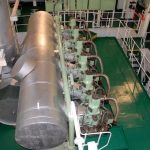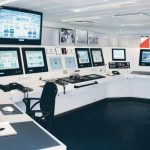What are the advantages and disadvantages of both electrical and pneumatic control systems on ships ?
Electrical Control System
Advantages
1. No air compressor and associated machinery required.
2. High efficiency since there is no leakages.
3. Instantaneous response.
4. Very little affected by normal temperature variations.
5. Very accurate.
6. Electric cables are cheap and easy to lay.
Disadvantages
1. The system require uninterrupted power supply with no voltage fluctuations.
2. Standby batteries required in case of power failure.
1. There is risk of fire due to overheating. Expensive intrinsically safe / explosion proof equipment may be required.
2. Moisture may cause damage to the system.
3. Damage readily occurs in the event of a fire.
Pneumatic Control System
Advantages
1. Not affected by ship’s power supply variations for short term.
2. No heat generated and hence no risk of fire.
3. Actuators are cheaper and accurate than electric systems.
4. Simple control air piping system.
Disadvantages
1. Require air compressor and associated systems.
2. A clean, dry and oil free supply of good quality air is essential for satisfactory operation of the system.
3. Good quality air require driers, filters with drains, etc. which increases maintenance.
4. May have transmission lags in large systems.
What is meant by ‘fail safe’ and ‘fail set’ in a pneumatic control systems ?
On failure of control air supply, the pneumatic actuator may be arranged to move to a position that allows the plant to continue to operate safely, in other words, fully opened or fully closed. This is known as fail safe. For example, in the case of a jacket cooling water system, on failure of control air, the actuator opens fully to allow jacket water to the cooler without bypass. On the other hand a fuel oil control valve for boiler closes completely on such a failure. This ensures safety of the plant.
In some other systems, control air supply failure locks the position of valve at that time of failure. This is called fail set. The advantage of this system is that the plant gets stable and have time for normal shutdown or can wait for reestablishment of control air supply for some time. Example for such a system is boiler water level control.
Explain two step control action, ratio control and proportional plus integral control with applications on ships ?
Two step control action is the simplest form of control, in that it assumes one or two preset positions, a switch is ON or OFF or in the case of a valve it is OPEN or CLOSE. For example, a pressure switch controlling the starting air compressor is an acceptable form of control since there can be fairly large deviation between measured value and desired value. Another example is hydrophore pumps which cut in and cut off with the hydrophore pressure.
Ratio control is one in which one variable is kept at a fixed ratio to another variable. Ratio control is found in boiler combustion control system where the ratio between the air-fuel must be controlled to ensure good combustion. The air flow is controlled by dampers to match the fuel flow.
What is the effect of a leaking proportional bellows or measurement bellows in pneumatic control systems ?
When proportional bellows start leaking, its ability to introduce the negative feedback is reduced. This results in increased gain of the controller and control valve starts moving to the extreme positions causing instability.
When measurement bellows leak, it prevent the flapper from moving towards the nozzle, and the desired or set value is changed, again causing hunting of the system.


